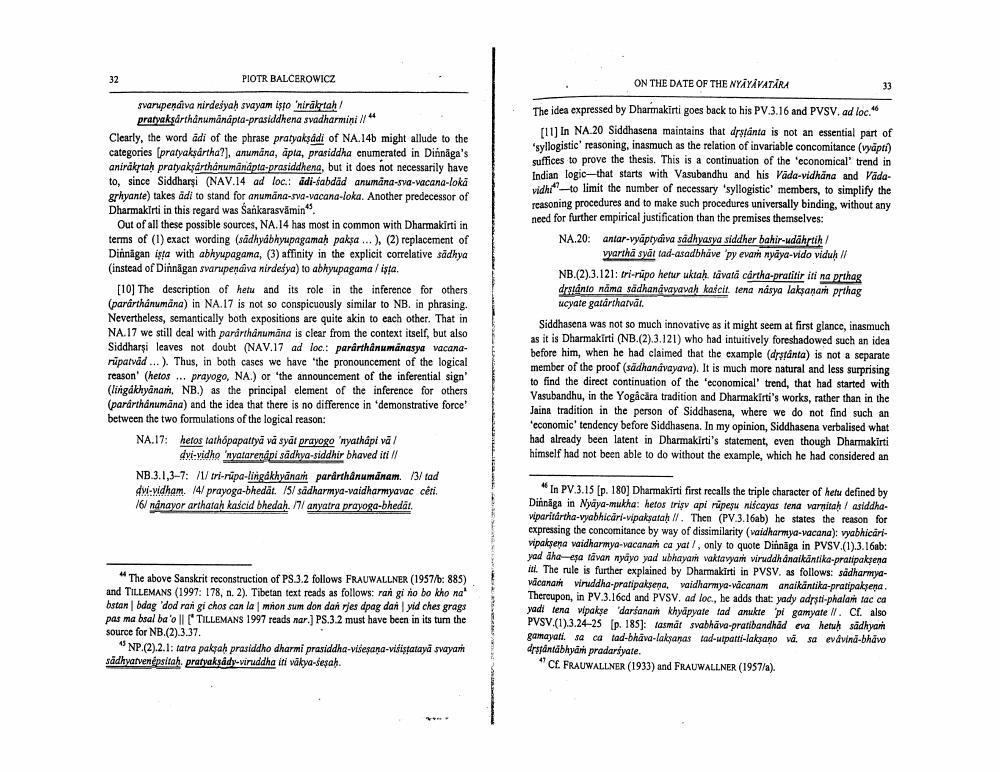Book Title: On The Date Of The Nnyayavatara Author(s): Piotr Balcerowicz Publisher: Piotr Balcerowicz View full book textPage 9
________________ PIOTR BALCEROWICZ ON THE DATE OF THE NYAYAVATĀRA svarupenda nirdesyah Svayam isto nirayah pratyakarthinumanapta-prasiddhena svadhamini //" Clearly, the word adi of the phrase pratyaksădi of NA 14b might allude to the categories (pratyakartha?), anumana, apla, prasiddha cnumerated in Dinnaga's anirektah pratyak drtharumānapla-prasiddhena, but it does not necessarily have to, since Siddharsi (NAV.14 ad loc.: adi-sabdad anumana-sya-vacana-loka grhyante) takes adi to stand for anumana-sya-vacang-loka. Another predecessor of DharmakIrti in this regard was Sankarasvamin". Out of all these possible sources, NA.14 has most in common with Dharmakirti in terms of (1) exact wording (sadhyabhyupagamah paksa ...), (2) replacement of Dinnlgan ista with abhyupagama, (3) affinity in the explicit correlative sadhya (instead of Dinnagan svarupenaiva nirdesya) to abhyupagama/ista. [10] The description of hetu and its role in the inference for others (pardrthånumána) in NA.17 is not so conspicuously similar to NB. in phrasing Nevertheless, semantically both expositions are quite akin to each other. That in NA. 17 we still deal with pararthanumana is clear from the context itself, but also Siddharsi leaves not doubt (NAV.17 ad loc: pararthanumanasye vacangriparudd ...). Thus, in both cases we have the pronouncement of the logical reason' (hetos ... prayogo, NA.) or the announcement of the inferential sign (lingdkhyanan, NB.) as the principal element of the inference for others (pardirthdnumana) and the idea that there is no difference in demonstrative force between the two formulations of the logical reason: NA.17: hetos tarhópapatya va syat prayogo "nyathapi val dvi vidho 'myalarenápi sadhwa-siddhir bhaved iti / NB.3.1.3-7: //tri-rúpa-lingåkhyanan pararthanumanam./3/ tad dw-vidham. /4/ prayoga-bhedāt. // sadharmya-valdharmyavac ceti. 16/ nanayor arthatah kaścid bhedah. ni ayatra prayora-bhedat The idea expressed by Dharmakirti goes back to his PV.3.16 and PVSV. ad loc." (11) In NA.20 Siddhasena maintains that drstanta is not an essential part of syllogistic reasoning, inasmuch as the relation of invariable concomitance (vap) suffices to prove the thesis. This is a continuation of the 'economical' trend in Indian loric-that starts with Vasubandhu and his Väda-vidhana and Vadavidh -to limit the number of necessary "syllogistic' members, to simplify the reasoning procedures and to make such procedures universally binding, without any need for further empirical justification than the premises themselves NA.20: antar-vyāptydiva sadhyasya siddher bahir-udährtih vartha syarrad-asadbhave pyevanin nyaya-vido vidull NB.(2).3.121: tri-rūpo heturuktah. tavata cartha-pratitir iti na prihag drstanto nama sadhana wayavah kascit. tena násya laksana prthag uyate gatárthatvar. Siddhasena was not so much innovative as it might seem at first glance, inasmuch as it is Dharmakirti (NB.(2).3.121) who had intuitively foreshadowed such an idea before him, when he had claimed that the example (drsanta) is not a separate member of the proof (sadhanavayava). It is much more natural and less surprising to find the direct continuation of the economical' trend, that had started with Vasubandhu, in the Yogacara tradition and Dharmakirti's works, rather than in the Jaina tradition in the person of Siddhasena, where we do not find such an "economic' tendency before Siddhasena. In my opinion, Siddhasena verbalised what had already been latent in Dharmakirti's statement, even though Dharmakirti himself had not been able to do without the example, which he had considered an The above Sanskrit reconstruction of PS3.2 follows FRAUWALLNER (1957/b: 885) and TILLEMANS (1997: 178, n. 2). Tibetan text reads as follows rangi no bo kho na bstan bdag 'dod rangi chos can lamron sume don dan rjes dpag dan yid ches grags pas ma bual ba'o Il ["TILLEMANS 1997 reads nar.] PS.3.2 must have been in its turn the source for NB.(2).3.37. * NP.(2).2.1: tatra pakrah prasiddho dharmi prasiddha-visesana-visistataya svayani sadhyavenépsitah pratyakşády-viruddha iti vākya-sesah. "In PV.3.15 (p. 180] Dharmakirti first recalls the triple character of het defined by Dinnaga in Nyaya mukha: hetos frisy api rupesu niscayas fend varnitah / asiddha viparitartha-vyabhicari-vipaksatah ll. Then (PV.3.16ab) he states the reason for expressing the concomitance by way of dissimilarity (valdharmiya vacana): vyabhicalvipaksena waidharmyo-vacanam ca yat/, only to quote Dinnaga in PVSV.(1).3.16ab: yad dha esa tavan nyayo yad ubhayam vaktavya viruddh dnaikantika-pratipakena tel. The rule is further explained by Dharmakirti in PVSV. as follows: sadharmyadanam vineddha-pratipaksena, vaidharmya-vacanamanaikantiko-pratipaksena Thereupon, in PV.3.16cd and PVSV. ad loc, he adds that: yady adrsti-phalari fac ca yad! tena vipakse 'darsanam khyapyale fad anukte pi gamyate II. Cl. also PVSV.(1).3.24-25 fp. 185): tasmåt svabhāva-pranibandhad eva hetuh sådhya gamayati sa ca tad-bhava-laksanas tad-utpatti-laksanova. sa evdvind-bhavo drsnabhyart pradariyate. "CE. FRAUWALLNER (1933) and FRAUWALLNER (1957/a).Page Navigation
1 ... 7 8 9 10 11 12 13 14 15 16 17 18 19 20 21
